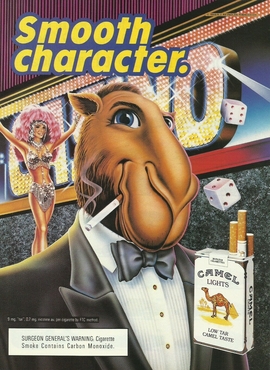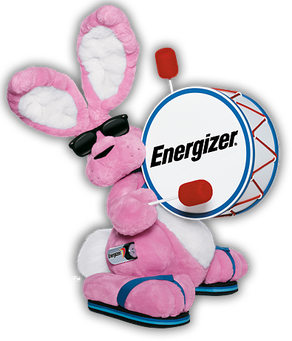
Six Flags Entertainment Corporation, formerly Six Flags Theme Parks, Inc., is an American amusement park corporation, headquartered in Arlington, Texas. It has properties in Canada, Mexico, and the United States. Six Flags owns the most theme parks and waterparks combined of any amusement-park company and has the seventh highest attendance in the world. The company operates 27 properties throughout North America, including theme parks, amusement parks, water parks, and a family entertainment center. In 2019, Six Flags properties hosted 32.8 million guests.

Joe Camel was an advertising mascot used by the R. J. Reynolds Tobacco Company (RJR) for their cigarette brand Camel. The character was created in 1974 for a French advertising campaign, and was redesigned for the American market in 1988. He appeared in magazine advertisements, clothing, and billboards among other print media and merchandise.

Stan Freberg was an American actor, author, comedian, musician, radio personality, puppeteer and advertising creative director.

Snickers is a brand of chocolate bar consisting of nougat topped with caramel and peanuts, all encased in milk chocolate. The bars are made by the American company Mars Inc. The annual global sales of Snickers is over $380 million, and it is widely considered the bestselling candy bar in the world.

Got Milk? is an American advertising campaign on television and YouTube encouraging the consumption of milk and dairy products. Created by the advertising agency Goodby Silverstein & Partners for the California Milk Processor Board in 1993, it was later licensed for use by milk processors and dairy farmers. It was launched in 1993 by the "Aaron Burr" television commercial, directed by Michael Bay. The national campaign, run by MilkPEP began to add the "got milk?" logo to its "Milk Mustache" ads in 1995.
Negative campaigning is the process of deliberately spreading negative information about someone or something to worsen the public image of the described. A colloquial, and somewhat more derogatory, term for the practice is mudslinging.
In political campaigns, an attack ad is an advertisement designed to wage a personal attack against an opposing candidate or political party in order to gain support for the attacking candidate and attract voters. Attack ads often form part of negative campaigning or smear campaigns, and in large or well-financed campaigns, may be disseminated via mass media.

A parody advertisement is a fictional advertisement for a non-existent product, either done within another advertisement for an actual product, or done simply as parody of advertisements—used either as a way of ridiculing or drawing negative attention towards a real advertisement or such an advertisement's subject, or as a comedic device, such as in a comedy skit or sketch.

The Energizer Bunny is the marketing mascot of Energizer batteries in North America. It is a pink mechanical toy rabbit wearing sunglasses and blue and black striped flip-flops that beats a bass drum bearing the Energizer logo.
The "Stand By Your Ad" provision (SBYA) of the Bipartisan Campaign Reform Act, enacted in 2002, requires candidates in the United States for federal political office, as well as interest groups and political parties supporting or opposing a candidate, to include in political advertisements on television and radio "a statement by the candidate that identifies the candidate and states that the candidate has approved the communication". The provision was intended to force political candidates running any campaign for office in the United States to associate themselves with their television and radio advertising, thereby discouraging them from making controversial claims or attack ads.

Spuds MacKenzie is a fictional dog character used for an extensive advertising campaign marketing Bud Light beer in the late 1980s. The Spuds MacKenzie mascot and campaign was the idea of a 23-year-old art director, Jon Moore. At the time, he was working at Needham, Harper, and Steers, a Chicago advertising agency. The dog first showed up in a Bud Light Super Bowl XXI ad in 1987.

The Budweiser Frogs are three lifelike puppet frogs named "Bud", "Weis", and "Er", who began appearing in American television commercials for Budweiser beer during Super Bowl XXIX in 1995. Adweek called it one of the "most iconic alcohol campaigns in advertising history". The first Budweiser Frogs commercial was created by David Swaine, Michael Smith and Mark Choate of DMB&B/St. Louis. The commercial was directed by Gore Verbinski, who would later direct the first three Pirates of the Caribbean films.
Apple has used a variety of advertising campaigns to promote its iPod portable digital media player. The campaigns include television commercials, print ads, posters in public places, and wrap advertising campaigns. These advertising techniques are unified by a distinctive, consistent style that differs from Apple's other ads.
"Bo Knows" was an advertising campaign for Nike cross-training shoes that ran in 1989 and 1990 and featured professional baseball and American football player Bo Jackson. It was also used as an advertising campaign for EA Sports’ Madden NFL 22.
In the 2006 federal election in Canada, the Liberal Party of Canada used attack ads against Conservative Party of Canada leader Stephen Harper. The Liberals, trailing in polls during the last weeks of the campaign, resorted to strong and often questionable negative ads directed towards the Conservative party, by attempting to depict Harper as an extreme right-wing politician. The advertisements were generally seen as excessive, and failed to prevent a Conservative victory.

The "Get a Mac" campaign is a television advertising campaign created for Apple Inc. by TBWA\Media Arts Lab, the company's advertising agency, that ran from 2006 to 2009. The advertising campaign ran in the United States, Canada, Australia, New Zealand, the United Kingdom, Japan, and Germany.
Nuts and Wine was a theatrical revue, with lyrics by C. H. Bovill and P. G. Wodehouse and music by Frank E. Tours, with additional numbers by Guy Jones and Melville Gideon, from a book by Bovill and Wodehouse. It was performed at the Empire Theatre, London, opening on 3 January 1914. The show closed on 28 March 1914, after a run of 12 weeks.
Throughout its history, the German automotive company Volkswagen has applied myriad advertising methods.
Mountain is a 2003 television and cinema advertisement launched by Sony Corporation to promote the PlayStation 2 video game console. The budget for production and advertising space purchases for the 60-second piece amounted to £5m across all markets. The commercial depicts a Brazilian crowd congregating to form a mountain of human bodies, all competing to reach the top of the pile. The campaign surrounding Mountain was handled by advertising agency TBWA London. The commercial was directed by Frank Budgen. Production was contracted to Gorgeous Enterprises, with post-production by The Mill. Mountain premiered in 30 countries on 13 November 2003.

Dumb Ways to Die is an Australian public campaign made by Metro Trains in Melbourne, Victoria to promote railway safety. The campaign video went viral on social media after it was released in November 2012. The campaign's animation was developed into an app available to iOS and Android devices.











